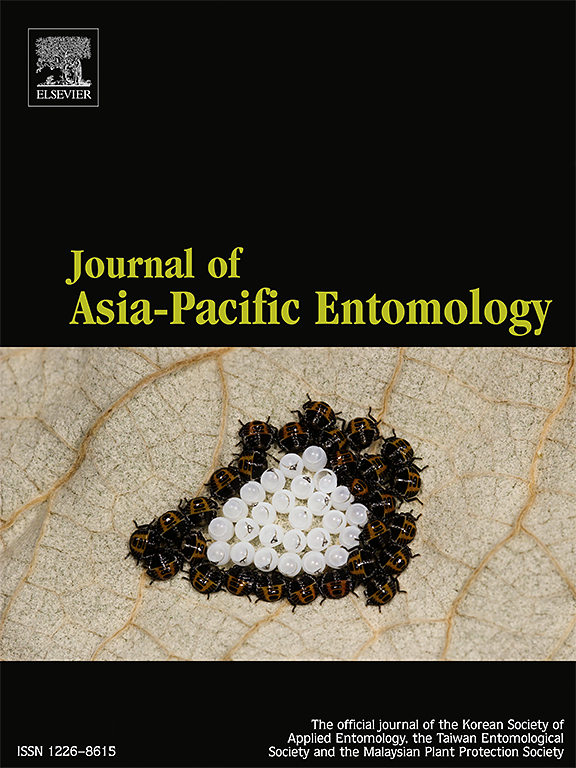Chemical compositions and insecticidal activities of Clausena lenis (Rutaceae) and Clausena excavata (Rutaceae) essential oils against two stored-product insects
IF 1.3
3区 农林科学
Q3 ENTOMOLOGY
引用次数: 0
Abstract
Tribolium castaneum Herbst, 1797 (Coleoptera: Tenebrionidae) and Lasioderma serricorne Fabricius, 1792 (Coleoptera: Anobiidae) are two globally prevalent stored-product pests. Traditional management strategies primarily involve the use of synthetic insecticides and repellents. However, plant essential oils (EOs) pose lower risks to human health and ecological environment. This study focused on two Clausena species plants, Clausena lenis and Clausena excavata, exploring the insecticidal and repellent properties of EOs extracted from different parts of them against T. castaneum and L. serricorne. The EOs were extracted via hydrodistillation and analyzed by gas chromatography-mass spectrometry (GC–MS). A total of 57 components were identified. The EOs from the branches and leaves of two Clausena plants were primarily composed of sesquiterpenes, while C. lenis fruits EO was mainly composed of monoterpenes (58.79 %) and esters (38.95 %). Clausena lenis leaves EO demonstrated the highest contact toxicity against T. castaneum, with a mortality rate of 72 % at a concentration of 50 %, while C. lenis branches EO was particularly effective against L. serricorne, with an LD50 of 8.24 mg/L air. In addition, C. lenis fruits EO exhibited the best repellent effect against these two pests. According to these results, C. lenis and C. excavata show promise to be developed into eco-friendly botanical insecticides for the prevention and control of stored-product pests, especially for application in agricultural storage. These findings highlight the potential for these EOs to serve as sustainable alternatives to synthetic insecticides, offering a safer and environmentally friendly approach to pest management in stored agricultural products.

荆芥(芸香科)和荆芥(芸香科)精油对两种储物昆虫的化学成分及杀虫活性研究
castaneum Herbst, 1797(鞘翅目:拟甲科)和Lasioderma serricorne Fabricius, 1792(鞘翅目:拟甲科)是两种全球流行的储藏产品害虫。传统的管理策略主要涉及使用合成杀虫剂和驱虫剂。然而,植物精油对人类健康和生态环境的风险较低。本研究以Clausena lenis和Clausena excavata两种Clausena属植物为研究对象,探讨其不同部位提取物对castaneum和L. serricorne的杀虫驱避作用。采用水蒸气蒸馏法提取,气相色谱-质谱联用(GC-MS)分析。共鉴定出57个成分。两种克氏木属植物的枝条和叶片中主要含有倍半萜,而克氏木属植物果实中主要含有单萜(58.79%)和酯类(38.95%)。竹叶精油对木栗螟的接触毒性最强,浓度为50%时死亡率为72%,竹叶精油对细纹螟的接触毒性最强,LD50为8.24 mg/L。其中,桔梗果EO对这两种害虫的驱避效果最好。综上所述,青霉和青霉具有开发成为防治储粮害虫的生态友好型植物性杀虫剂的潜力,特别是在农业储粮中应用前景广阔。这些研究结果强调了这些有机农药作为合成杀虫剂的可持续替代品的潜力,为储存农产品的有害生物管理提供了一种更安全、更环保的方法。
本文章由计算机程序翻译,如有差异,请以英文原文为准。
求助全文
约1分钟内获得全文
求助全文
来源期刊

Journal of Asia-pacific Entomology
Agricultural and Biological Sciences-Insect Science
CiteScore
2.70
自引率
6.70%
发文量
152
审稿时长
69 days
期刊介绍:
The journal publishes original research papers, review articles and short communications in the basic and applied area concerning insects, mites or other arthropods and nematodes of economic importance in agriculture, forestry, industry, human and animal health, and natural resource and environment management, and is the official journal of the Korean Society of Applied Entomology and the Taiwan Entomological Society.
 求助内容:
求助内容: 应助结果提醒方式:
应助结果提醒方式:


